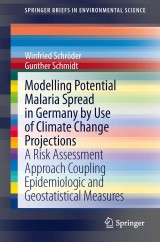Details

Modelling Potential Malaria Spread in Germany by Use of Climate Change Projections
A Risk Assessment Approach Coupling Epidemiologic and Geostatistical MeasuresSpringerBriefs in Environmental Science
|
CHF 59.00 |
|
| Verlag: | Springer |
| Format: | |
| Veröffentl.: | 14.12.2013 |
| ISBN/EAN: | 9783319038230 |
| Sprache: | englisch |
Dieses eBook enthält ein Wasserzeichen.
Beschreibungen
This book investigates the spatial distribution of potential temperature-driven malaria transmissions, using the basic reproduction rate (R0) to model the reproduction of the malaria pathogen Plasmodium vivax. The authors mapped areas at risk of an outbreak of tertian malaria in the federal state of Lower Saxony (pre-study) and for whole Germany (main-study) by means of geostatistics for past (1947-2007) and future periods. Projections based on predicted monthly mean air temperature data derived from the IPCC and regionally discriminated by two regional climate models (REMO, WettReg) for the countrywide study.
1. Background and Goals.- 2. Case Study 1: Modelling Potential Transmission Gates of Malaria Tertiana in Lower Saxony.- 3. Case Study 2: Modelling Potential Transmission Gates of Malaria Tertiana in Germany.- 4. Conclusions and Outlook.
<p>One of the most troubling and dangerous effects of climate warming is the potential for new outbreaks of vector-borne diseases – in humans as well as livestock – that had previously been eradicated, or at least effectively suppressed. One such threat is malaria. Although it is often believed to be restricted to the tropics and developing countries, climate change could bring malaria back to Europe, especially into countries where it was present until the middle of the last century, such as Germany, where Tertian malaria or vivax malaria, a rather severe form of malaria, was prevalent in north-western parts of the country until the 1950s, when it was eradicated. The vector itself, the mosquito (Anopheles atroparvus), is still present, and infected people from malarial regions could introduce a new onset of malaria.</p><p>This book investigates the spatial distribution of potential temperature-driven malaria transmissions, using the basic reproduction rate (R0) to model the reproduction of the malaria pathogen Plasmodium vivax. The authors mapped areas at risk of an outbreak of tertian malaria in the federal state of Lower Saxony (pre-study) and for whole Germany (main-study) by means of geostatistics for past (1947-2007) and future periods. Projections based on predicted monthly mean air temperature data derived from the IPCC and regionally discriminated by two regional climate models (REMO, WettReg) for the countrywide study.</p><p>The transmitted parasites usually benefit from increased temperatures as both their reproductive and development cycles are accelerated. The resulting maps show that the seasonal transmission gate may be extended from an average of 3 months under present temperature conditions to up to 6 months in the climate reference period 2051-2080. Although models described in this book do not integrate such other driving factors as the distribution of water bodies serving as breeding habitats, or population density, the findingsilluminated here could prove useful for establishing a monitoring scheme and for investigation and assessment of related diseases caused by temperature-dependent vectors and pathogens, including many which are dangerous for livestock.</p>
Offers a sophisticated risk assessment approach which links epidemiological and geostatistical measures Applies regional temperature projections to research on the impacts of climate change Shows how modeling can help to identify areas at risk in an epidemiological context with the aim of initiating preventative measures Includes supplementary material: sn.pub/extras
Diese Produkte könnten Sie auch interessieren:

Decision Support Systems for Risk-Based Management of Contaminated Sites

von: Antonio Marcomini, Glenn Walter Suter II, Andrea Critto

CHF 118.00

Dynamics of Mercury Pollution on Regional and Global Scales

von: Nicola Pirrone, Kathryn R. Mahaffey

CHF 177.00














